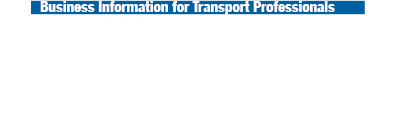A European view
European Transport Commissioner Antonio Tajni answers Transport Business’ questions about the main issues affecting road transport within Europe, toll schemes and targets for reducing carbon emissions
Are levels of car ownership growing in Europe?
Road transport is the dominant transport mode and consumed 82 per cent of total energy in the transport sector in 2005. Private cars represent the dominant transport mean in road transport, accounting for 55.9 per cent of total energy consumed in road transport in 2005.
Average occupancy is projected to attain 2.17 passengers per car in 2030 down from 2.41 in 2005. The projection includes a significant expansion of car sales in the EU, which leads to ownership of 710 cars per 1,000 persons in 2030, up from 460 in 2005 and 350 in 1990. The average cars mileage is shown to decrease steadily at an average rate of 0.1 per cent per year, continuing past trends.
The combined effects of the above trends result in a decrease in the energy intensity of car transportation. It is projected to be equal to 0.84 per cent on average per year in the period 2005 to 2030.
What do you perceive to be the main issues affecting road transport within Europe over the next decade?
The transport sector is one of the most important sectors for the development of energy consumption and environmental emissions. The nearly complete dependence of the sector on oil products generates two sorts of concerns: security of oil supply with rising needs for transportation; and worries about climate change combined with longer standing problems of congestion, noise and urban pollution.
A closer look at the period 2000 to 2005 shows that the GDP elasticity of passenger transport remained constant at a level just below one, but for freight transportation it became as high as 1.45. This reflects the considerable increase in commodity trading following the EU enlargement and the market integration. The high value of GDP elasticity reflects a transitory phenomenon and it is likely that in the future freight transportation will grow at most as fast as GDP.
Citizens should be at the heart of the European common transport policy. The appropriate operation of the transport system is essential to the quality of life for the citizens. Most terrestrial transport is carried out today by road, i.e. 90 per cent of the terrestrial passenger transports and 80 per cent of the terrestrial freight transport. Roads provide effectiveness and flexibility, both of which are appreciated by companies and consumers.
Road transport services account for 1.6 per cent of our GDP and give jobs to 4.5 million people in the EU. The whole economy and society depends heavily on efficient road transport. The Community policy objectives for road transport exist to promote efficient road freight and passengers transport services, to create fair conditions for competition, to promote and harmonise safer and more environmental friendly technical standards, to ensure a minimum fiscal and social harmonisation, and to make sure that the rules in road transport are effectively applied without discrimination.
The EU has 850,000 road transport operators. It is estimated that road haulage will increase by 55 per cent between 2000 and 2020 and by twice that figure for international transport. 50 per cent of EU exports to Russia now travel by road, and trade by land transport, both road and rail, between the parties is set to grow by 11 per cent a year.
The European Commission adopted three proposals aimed at modernising the rules governing admission to the occupation of road transport operator and access to the road transport market. The proposals provide for compulsory training for transport managers, an enforceable definition of cabotage, which can be carried out within a Member State, and mechanisms for imposing sanctions across the national borders. The proposed regulations will reduce distortions of competition and improve transport operators' compliance with the provisions of social legislation and road safety rules. According to the impact assessment, the administrative costs borne by companies and the authorities could be reduced by as much as €190 million per annum.
The legislative package adopted today comprises three proposals for regulations, aimed at modernising, simplifying and streamlining the rules governing admission to the occupation and access to the market in the road haulage and passenger transport sector, and a report on the application of the Working Time Directive to self-employed drivers. This package proposes seven main changes to harmonise the application of the rules, improve the effectiveness of checks and ensure fair competition.
The Commission has also adopted a report on the implementation of the directive on the roadworthiness testing of commercial vehicles. According to the report, despite great efforts by some Member States, there is still a lack of uniformity with regard to checks within the EU. The Commission will refer the matter to the appropriate committee to examine (in conjunction with the Member States) how the situation can be improved.
Are road pricing/tolls schemes being unified throughout Europe?
Existing distortions of competition cannot be eliminated solely by harmonising taxes or fuel excise duties; however, until technically and economically more appropriate forms of levy are in place, such distortions may be attenuated by the possibility of retaining or introducing tolls and/or user charges for the use of motorways. In addition, Member States should be allowed to levy charges for the use of bridges, tunnels and
mountain passes.
Tolls and user charges should not be discriminatory nor entail excessive formalities or create obstacles at internal borders; therefore, adequate measures should be taken to permit the payment of tolls and user charges at any time and with different means of payment.
Tolls shall be levied according to the distance travelled and the type of vehicle; user charges are scaled according to the duration of the use made of the infrastructure and to vehicles emission classes. Both tolls and user charges can only be imposed on users of motorways or multi-lane roads similar to motorways as well as on users of bridges, tunnels and mountain passes.
The directive does not permit to impose a toll and a user charge at the same time. However, tolls can be levied on networks where user charges are already imposed for the use of bridges, tunnels and mountain passes.
National tolls and charges should not be discriminatory and should be set out in such a way to cause as little hindrance as possible to the free flow of traffic as well as to avoid mandatory checks at internal borders. At national level specific taxes or charges for the registration of the vehicle or for its abnormal weights/dimension can be imposed and all needed measures to combat road traffic congestion can be adopted.
A specific provision of the directive allows Member States to co-operate for the purpose of introducing a common system of user charges. In this respect Belgium, Denmark, Luxembourg, the Netherlands and Sweden have a common system of user charges for heavy goods vehicles above 12 tonnes called the ‘Eurovignette’ system. According to this system the payment of a specified amount confers on hauliers the right to use motorways of the participating Member States for a given period (i.e. a day, a week, a month or a year). Each participating country is responsible for all aspects related to the payment of the Eurovignette on its own territory.
Although the application of tolls and user charges is not mandatory for Member States, all framework conditions set out in the directive should be fulfilled in case of their opting for levying such charges. This will ensure that tolls and user charges are applied evenly and fairly.
The rates of user charges should be based on the duration of the use made of the infrastructure in question and be differentiated in relation to the costs caused by the road vehicles.
In order to ensure that user charges and tolls are applied homogeneously, certain rules for determining their manner of application should be laid down, such as the characteristics of the infrastructure to which they are applicable, the maximum levels of certain rates and other general conditions that will have to be complied with.
Are the targets currently in place for reducing carbon emission levels effective and how will they continue to be monitored?
Now the tide is turning again in favor of carbon markets in the United States. Although the Senate recently blocked a bill that would have imposed a cap and trade system to slash greenhouse gases by 2050, both candidates for the presidency have pledged support for market-based systems like the one in Europe.
Carbon markets, also known as cap and trade systems, have come into vogue because they are more politically palatable than imposing new carbon taxes.
The previous voluntary agreements on CO2 emissions from cars were not effective and that is why the Commission has proposed legislation. The new target becomes binding in 2012 - this is the first year in which the fleet average of each manufacturer must respect the limit value curve.
The 120g/km are to be achieved under an integrated approach: 130g/km as in the standard test, and 10g/km through additional measures.
Please register to comment on this article

